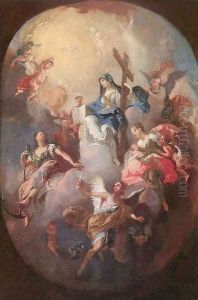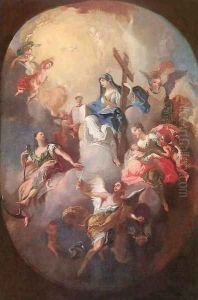Josef the Younger Winterhalter Paintings
Josef the Younger Winterhalter, born in 1827, was a notable German painter who contributed significantly to the artistic landscape of the 19th century. He was the younger brother of the famed portraitist Franz Xaver Winterhalter, who was renowned for his depictions of European aristocracy, including Queen Victoria and Empress Eugénie. Josef was born into a family deeply immersed in the arts in Menzenschwand, now part of St. Blasien in the Black Forest region of Germany. His early life was shaped by the artistic milieu fostered by his family, particularly under the influence of his elder brother, Franz Xaver, whose success and style had a profound impact on Josef's career.
Josef Winterhalter, despite often being overshadowed by the fame of his brother, carved out his own niche in the art world. He received his formal education in the arts at the Academy of Arts in Munich, where he honed his skills and developed his own artistic voice. Unlike his brother, whose work primarily focused on portraiture, Josef's oeuvre included a broader range of subjects, including landscapes, historical scenes, and genre paintings. However, he did also engage in portraiture, and his works in this genre exhibit a keen eye for detail and a delicate handling of textures, much like his brother's celebrated portraits.
Throughout his career, Josef the Younger Winterhalter exhibited his works in various prestigious venues, gaining recognition and accolades for his artistic achievements. His paintings were appreciated for their technical skill, composition, and the sensitivity with which he portrayed his subjects. Despite this, his work has not been as extensively studied or celebrated as that of Franz Xaver Winterhalter, leading to a somewhat secondary position in the annals of 19th-century art history.
After decades of contributing to the artistic scene, Josef the Younger Winterhalter passed away in 1911. His legacy, while closely intertwined with that of his brother, stands on its own merits for its contribution to the diversity and richness of 19th-century German art. Today, his works can be found in various collections and museums, where they continue to be studied and appreciated by art historians and enthusiasts alike. Josef the Younger Winterhalter remains an important figure for those interested in the breadth and depth of the Winterhalter family's impact on European art.

